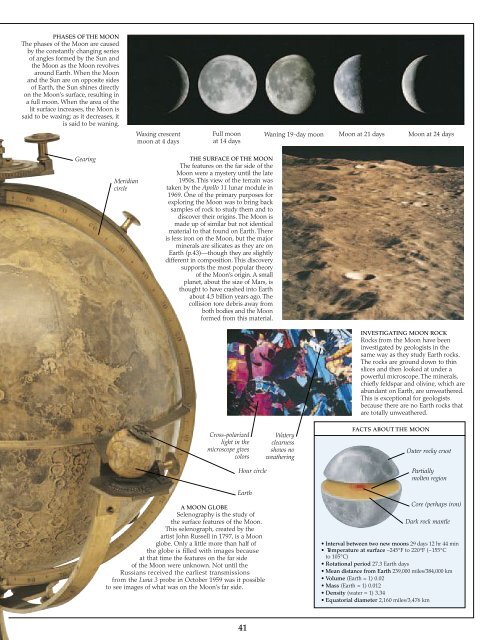DK Eyewitness - Astronomy
Create successful ePaper yourself
Turn your PDF publications into a flip-book with our unique Google optimized e-Paper software.
Phases of the moon<br />
The phases of the Moon are caused<br />
by the constantly changing series<br />
of angles formed by the Sun and<br />
the Moon as the Moon revolves<br />
around Earth. When the Moon<br />
and the Sun are on opposite sides<br />
of Earth, the Sun shines directly<br />
on the Moon’s surface, resulting in<br />
a full moon. When the area of the<br />
lit surface increases, the Moon is<br />
said to be waxing; as it decreases, it<br />
is said to be waning.<br />
Waxing crescent<br />
moon at 4 days<br />
Full moon<br />
at 14 days<br />
Waning 19-day moon Moon at 21 days Moon at 24 days<br />
Gearing<br />
Meridian<br />
circle<br />
The surface of the moon<br />
The features on the far side of the<br />
Moon were a mystery until the late<br />
1950s. This view of the terrain was<br />
taken by the Apollo 11 lunar module in<br />
1969. One of the primary purposes for<br />
exploring the Moon was to bring back<br />
samples of rock to study them and to<br />
discover their origins. The Moon is<br />
made up of similar but not identical<br />
material to that found on Earth. There<br />
is less iron on the Moon, but the major<br />
minerals are silicates as they are on<br />
Earth (p.43)—though they are slightly<br />
different in composition. This discovery<br />
supports the most popular theory<br />
of the Moon’s origin. A small<br />
planet, about the size of Mars, is<br />
thought to have crashed into Earth<br />
about 4.5 billion years ago. The<br />
collision tore debris away from<br />
both bodies and the Moon<br />
formed from this material.<br />
Investigating moon rock<br />
Rocks from the Moon have been<br />
investigated by geologists in the<br />
same way as they study Earth rocks.<br />
The rocks are ground down to thin<br />
slices and then looked at under a<br />
powerful microscope. The minerals,<br />
chiefly feldspar and olivine, which are<br />
abundant on Earth, are unweathered.<br />
This is exceptional for geologists<br />
because there are no Earth rocks that<br />
are totally unweathered.<br />
Cross-polarized<br />
light in the<br />
microscope gives<br />
colors<br />
Watery<br />
clearness<br />
shows no<br />
weathering<br />
Facts about the moon<br />
Outer rocky crust<br />
Hour circle<br />
Earth<br />
A moon globe<br />
Selenography is the study of<br />
the surface features of the Moon.<br />
This selenograph, created by the<br />
artist John Russell in 1797, is a Moon<br />
globe. Only a little more than half of<br />
the globe is filled with images because<br />
at that time the features on the far side<br />
of the Moon were unknown. Not until the<br />
Russians received the earliest transmissions<br />
from the Luna 3 probe in October 1959 was it possible<br />
to see images of what was on the Moon’s far side.<br />
Partially<br />
molten region<br />
Core (perhaps iron)<br />
Dark rock mantle<br />
• Interval between two new moons 29 days 12 hr 44 min<br />
• Temperature at surface –245°F to 220°F (−155°C<br />
to 105°C)<br />
• Rotational period 27.3 Earth days<br />
• Mean distance from Earth 239,000 miles/384,000 km<br />
• Volume (Earth = 1) 0.02<br />
• Mass (Earth = 1) 0.012<br />
• Density (water = 1) 3.34<br />
• Equatorial diameter 2,160 miles/3,476 km<br />
41


